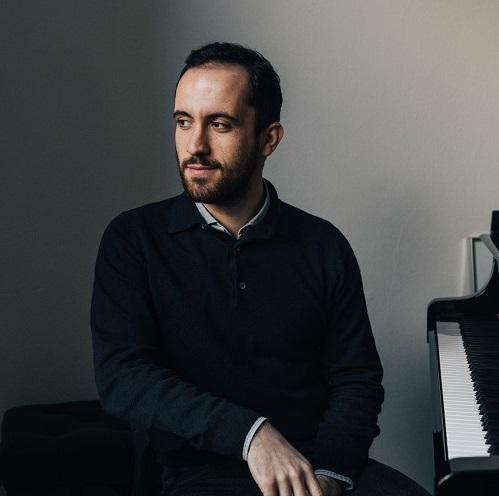Worlds collide in Levit’s bifurcated “Life” program

Igor Levit performed Friday night at Carnegie Hall. Photo: Robbie Lawrence
The challenge of any abstract art is to discern what it is saying, if indeed it is saying anything at all. That challenge is fundamental to music which, when without text, is abstract by nature.
What does music mean? If it’s sensual or emotional, what are the specific feelings and sensations we should experience? Is this kind of expression even possible?
Those are the questions pianist Igor Levit faces on his new album, Life (Sony), and that he presented at a solo performance in Zankel Hall Friday night. The program is a personal one for Levit, who made Life in response to the death of his best friend.
Levit played a substantial selection of music from the album. He is among the finest pianists on the scene today and his playing was exceptional. Yet while this was an artistically ambitious event, the goals and means were problematic.
The entire enterprise boiled down to the question of meaning. This music means something to Levit, but what was that, and what was he trying to get the audience to feel? How was it that Bach, Busoni, Schumann, and Liszt spoke to and about life and loss? Did they offer solace, wisdom?
If the artist’s responsibility is to make that intent and inchoate meaning clear to the audience through the performance, Levit failed. But there is more than one way to think about a concert, and in terms of great playing of great music, Levit succeeded for the most part, although his very personal program didn’t make complete sense.
He began with Brahms’ arrangement for the left hand of the Chaconne from Bach’s Violin Partita No. 2. His playing was skillful and imaginative, manipulating the keyboard of the Steinway grand as if it were a harpsichord. But Brahms’ arrangement is in a way too pretty, too comfortable. Without the dry timbres of the violin and the fleeting harmonies of arpeggios and double-stops, the sound was too lush to capture the type of anguish and resolve in heart in the music.
The remainder of the first half was extraordinary. With a hushed concentration that captivated the audience, Levit played Busoni’s remarkable Fantasia nach J.S. Bach, K. 253, followed immediately by Schumann’s “Ghost” Variations on an Original Theme, WoO 24. Busoni also made a lush sound world out of Bach, mixing bits from chorales with Busoni’s own organ music, yet here the results were striking and uncanny.
Busoni’s purpose was to build a musical memorial after his father’s death, and the Fantasia sounds like Busoni improvising while meditating on his father, his memory and hands recalling bits of Bach that he weaves into passing phrases. Levit’s playing was deep, inward-turning and mesmerizing. One did not have to know his nor Busoni’s extra-musical purpose to feel that something personal and profound was being communicated.
The darkness of Levit’s interpretation was unusual, and more so than on the Life recording, and so the segue into the Schumann variations was affecting to the mind and spirit with a palpable sense of light shining into a sepulchral place. With the transition, Levit maintained the dreamlike intensity of his playing, and the sweet opening theme took on greater clarity and feeling. Levit played the last variation of this unfinished piece with a languid deliberation, lofting each insistent, bruising dissonance into the air until he separated the blue sorrow from the music. This was astonishing to experience and had one utterly spellbound.
Nothing like that happened in the second half, which was intellectually and aesthetically incomprehensible. Levit’s playing remained astounding, but in a different way—furious yet still exact. What he played required that, and what he played made no sense.
On their own, Liszt’s retooling of Wagner in his “Solemn March to the Holy Grail” from Parsifal, and Busoni’s transcription of Liszt’s Fantasia and Fugue on Meyerbeer’s “Ad nos, ad salutarem undam” would be spectacular showpieces on any recital. But as showpieces, they were the exact opposite of the deep experience of the first half.
The “March,” once one is past the crashing chords and the moments of Wagner’s transformative music, is not much of a piece. It is repetitive but, strangely for a march, goes nowhere in time nor in expression. It’s a model built to honor Wagner, and is so extroverted that any private feelings Levit may have had were drowned out.
There is far more expressive material in the Fantasia and Fugue, a virtuoso organ work Busoni adapted for the piano. Levit showed tremendous technique which alone was exciting for the audience, but excitement was the opposite of the point of the first half and of Life in general. His performance was in no way shallow, quite the opposite; but the loose form and improvisatory nature of the music seemed to seduce Levit. He took off too fast, too soon, and left the listener behind. One could feel the force of his expression but there was no door into just what it may have meant.
The encore was substantial, “A Mensch” from Fred Rzewski’s Dreams. Another fantasia-style piece, with little bits of the Largo from Dvorak’s Symphony No. 9 rising to the surface, “A Mensch” continued the inward exploration experienced in the first half, and could have replaced the original post intermission selections, holding together the possibility of an intensely meaningful evening of music.
Pierre-Laurent Aimard and Tamara Stefanovich play Messiaen’s Visions de l’Amen 7:30 p.m. Thursday in Zankel Hall. carnegiehall.org






